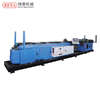Industry News
When designing and arranging pipes, avoid excessively large arcs, arbitrary curves, compound bends, and greater than 180. The arc. The excessively large arc not only makes the tooling bulky, but also is restricted by the size of the tube bending machine; the design of arbitrary curves and compound bending is very unreasonable, which greatly hinders mechanization and automated production, making it difficult for operators to get rid of heavy manual labor; Greater than 180. The arc makes the tube bending machine unable to unload the mold.
The bending radius should try to achieve "one tube, one mold" and "multiple tubes, one mold". For a pipe, no matter how many bends and bending angles there are, there can only be one bending radius. Because the pipe bender does not replace modules during the bending process, this is "one pipe, one mold". "Multi-tubes and one mold" means that tubes of the same diameter should be bent with the same bending radius as much as possible, that is, the same set of modules should be used to bend different shapes of tubes, which will help reduce the number of modules.
The bending radius of the catheter determines the resistance of the catheter during bending. Generally speaking, the pipe diameter is large and the bending radius is small. The tube bending machine is prone to internal wrinkles and slippage when bending, and the bending quality is difficult to guarantee. Therefore, the R value of the pipe bending die is generally 23 times the diameter of the pipe. The main influence of the bending forming speed on the forming quality is: too fast speed will easily cause the flattening of the curved part of the catheter, and the roundness will not meet the requirements, causing the catheter to be cracked or broken.
The bending radius should try to achieve "one tube, one mold" and "multiple tubes, one mold". For a pipe, no matter how many bends and bending angles there are, there can only be one bending radius. Because the pipe bender does not replace modules during the bending process, this is "one pipe, one mold". "Multi-tubes and one mold" means that tubes of the same diameter should be bent with the same bending radius as much as possible, that is, the same set of modules should be used to bend different shapes of tubes, which will help reduce the number of modules.
The bending radius of the catheter determines the resistance of the catheter during bending. Generally speaking, the pipe diameter is large and the bending radius is small. The tube bending machine is prone to internal wrinkles and slippage when bending, and the bending quality is difficult to guarantee. Therefore, the R value of the pipe bending die is generally 23 times the diameter of the pipe. The main influence of the bending forming speed on the forming quality is: too fast speed will easily cause the flattening of the curved part of the catheter, and the roundness will not meet the requirements, causing the catheter to be cracked or broken.








